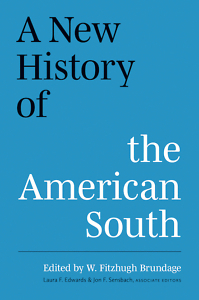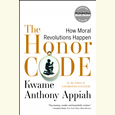What is “the South”?
Fitzhugh Brundage reflects on an ambitious undertaking: A New History of the American South
We tend to think of the South as a region drenched in tradition, resistant to change. A New History of the American South challenges that notion. The book’s editor, W. Fitzhugh Brundage, assembled 15 leading historians to explain the “wrenching transformations” in the South. The result is a landmark volume that explains the South from many different perspectives, through various interpretative lenses, over the course of centuries.

Fitzhugh Brundage is the William Umstead Distinguished Professor at the University of North Carolina at Chapel Hill. A historian of race, memory, and violence in the post-Civil War South, his books include The Southern Past: A Clash of Race and Memory and Civilizing Torture: An American Tradition, a finalist for the Pulitzer Prize in history. He answered questions via email from Chapter 16:
Chapter 16: What is the “old” history of the South? If this book came out 50 years ago, what would it look like?
Fitzhugh Brundage: Fifty years ago, a history of the South was almost certain to devote much (perhaps even most) attention to identifying the historical moment when the South deviated from the path pursued by the rest of the nation and then tracing the South’s subsequent deviation. Gallons and gallons of ink were devoted to defining Southern regional distinctiveness and measuring that distinctiveness over time.
That the South was distinctive was unquestioned. Perhaps the fullest expression of this assumption was Bertram Wyatt-Brown’s Southern Honor, published in 1984. Wyatt-Brown argues that the North and South had two fundamentally different codes that regulated the self; the South was an honor-bound society in which shame (and the fear of shame) dictated behavior, whereas the North was a guilt-based society, in which inhabitants internalized codes of behavior. This binary was at the foundation of the clash of civilizations that erupted in 1861 during the Civil War. This search for Southern distinctiveness was a catalyst for some exceptional scholarship, including Wyatt-Brown’s work. But eventually important, indeed, crucial facets of the history of the region received less attention.
For instance, 50 years ago the history of the colonial southern hinterlands — those portions of the southeastern United States far removed from the British seaboard colonies — were thin on the ground. Histories of women were even more exotic. And while studies of slavery from the perspective of slave masters were proliferating, the study of Blacks as historical agents was still nascent. Consequently, histories of the South a half-century ago inevitably focused on white male elites as the decisive agents in the history of the region.
Chapter 16: So what is the “new” history? How have scholars changed our understanding of the region?
Brundage: Historians now emphasize the historical agency and presence of all the region’s inhabitants. It is not just that the history of the South is more inclusive now, but that it is also “re-centered” in many regards. The early history of the region is no longer dominated by the Jamestown saga. No longer is the North presumed to be the standard against which contemporaries judged the South.
Chapter 16: A typical edited volume collects essays around a particular theme, but each author tends to focus on a specific, somewhat narrow topic. A New History of the American South, by contrast, asks each author to explain a major theme and era in Southern history, yet blend into a larger narrative. How did you manage this ambitious task?
 Brundage: A major element of the intellectual pleasure and craft of this volume was hosting a conversation about important threads the volume would trace across the long history of the region. We had to reach a consensus about what was important, in our eyes, and to then devise ways to pull those threads throughout the volume. The consensus that emerged speaks to the common interests and concerns of the authors and of the scholarly community at present. Yet, at the same time, contributors had license to incorporate the threads into their chapter as they deemed best. The result, we hope, is a narrative that is accessible and clear, and yet, at times, surprising and even idiosyncratic, in the best sense of the word.
Brundage: A major element of the intellectual pleasure and craft of this volume was hosting a conversation about important threads the volume would trace across the long history of the region. We had to reach a consensus about what was important, in our eyes, and to then devise ways to pull those threads throughout the volume. The consensus that emerged speaks to the common interests and concerns of the authors and of the scholarly community at present. Yet, at the same time, contributors had license to incorporate the threads into their chapter as they deemed best. The result, we hope, is a narrative that is accessible and clear, and yet, at times, surprising and even idiosyncratic, in the best sense of the word.
Chapter 16: Is it fair to classify race as an organizing principle in Southern history? Given today’s political battles over the past, what can this volume tell us about the historical currents of the region?
Brundage: That’s a daunting question to answer! First, I think it is important to recognize that the Southern states have only the briefest history of civic pluralism. Formal and informal power has for most of the region’s history been in the hands of a small number of residents. The civic traditions in the region since the nation’s founding have not encouraged tolerance of dissent or difference. Since roughly 1970, the South has experienced, in fits and starts, the creation of civic pluralism, which has been manifest in the most democratic politics the region has ever enjoyed and broadest participation in the region’s civic institutions.
The emergence of pluralism in the region has been uneven and halting, in part because the region itself is evolving in myriad ways. Whether we distinguish high-growth and low-growth regions, or map ethnic diversity onto the region, it is clear that the future of, say, Loudoun County in northern Virginia is certain to widen from that of Barbour County in southeastern Alabama. As a consequence, making projections about the future of “the South” as a cohesive region is certain to be a fool’s errand.
Chapter 16: In your introduction, you write about how, over time, we have defined and characterized the South. Should we emphasize what makes it distinctive, or what ties it to rest of the nation? What makes something “Southern”? Where is the South, anyway?
Brundage: Great questions. Provocative as well. I confess that I don’t have a concise answer to any of these. And the reason isn’t because as an academic I am obligated to make everything complicated. But rather because what has been defined as “Southern” has never been constant.
Let me offer two quick examples. I often ask my students to identify a defining Southern foodway. They usually say biscuits. The Southern embrace of biscuits is a post-Civil War phenomenon. Before then, most Americans associated Southerners with cornbread. Or think of the genre of country music. Country music unquestionably has deep roots in the American South. But in its formative years the genre was saturated with all manner of “Western” influences. And, crucially, the definition of “Southern” is in the eyes of the beholder. Plenty of “Southerners” will insist that Florida really isn’t Southern, or Texas isn’t Southern, or northern Virginia isn’t Southern, while Kentucky or Maryland is Southern. So I find it especially interesting to ask what is being identified as Southern by whom and in what context. Americans have and seem likely to continue to use “the South” to calibrate the traits and merits of all manner of things that are important to them.

Aram Goudsouzian is the Bizot Family Professor of History at the University of Memphis. His most recent book is The Men and the Moment: The Election of 1968 and the Rise of Partisan Politics in America.





